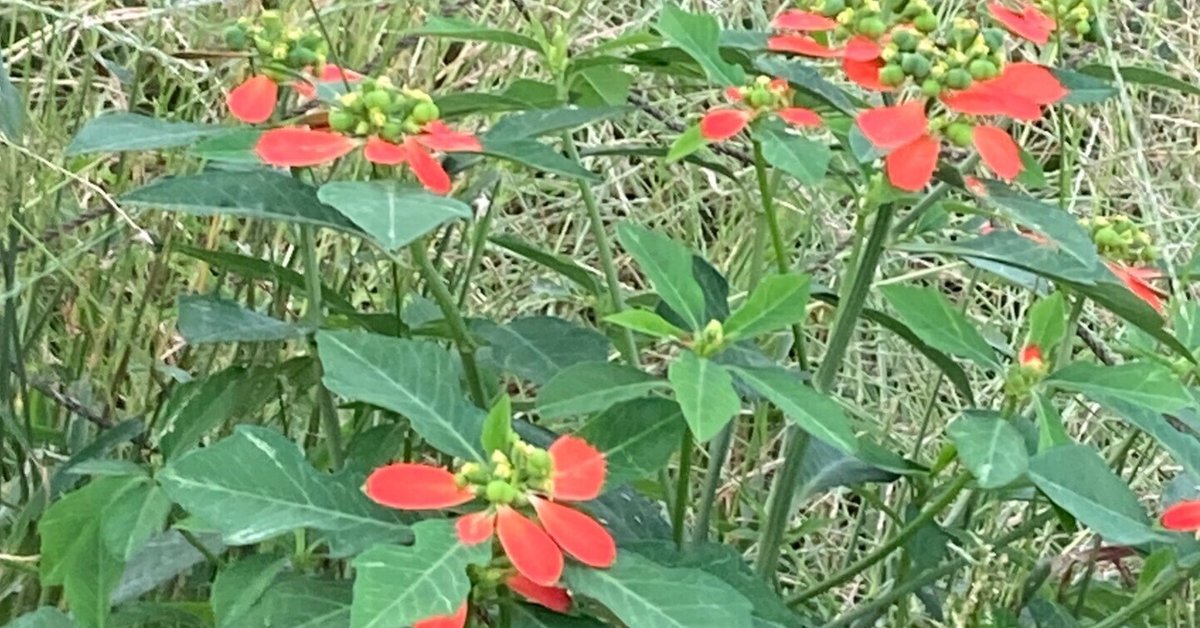
南河内郡太子町で出会った灯台草。植物分類は古代ローマにも本草綱目、洋の東西は問わない探究心。
20240925 南河内郡太子町、朝散歩で出会った、葉の部分が花の様に見える(トウダイグサ;灯台草)。古代ローマの医師エウフォルボス(Euphorbos)は、この乳液を治療に用いた、と言う事ですが、薬効はわ不明、との事。トウダイグサ科の植物には、有毒なものもありとの事。古代ローマ時代の紀元一世紀頃の人と思われるペダニオス・ディオスコリデス(Pedanius Dioscorides)の著した『薬物誌』De Materia Medica には、この植物に関する記述があるそうです。『薬物誌』De Materia Medicaはのオリジナル本はもう既になさそうです。エウフォルボスの方がディオスコリデスより古い時代の人と推察されますが、確定的な事は実証が難しい様です。西洋でも東洋でも植物の分類に果敢に情熱を燃やした人々が多く存在しました。
This plant, with brightly colored bracts that resemble flowers, is a species of Euphorbia. I encountered it during a morning walk in Taishi-Cho, Minamikawachi-Gun, Osaka-Fu. The ancient Roman physician Euphorbos is said to have used the plant's latex for medical treatment, but its medicinal properties remain unclear. Some Euphorbiaceae plants are known to be poisonous. The De Materia Medica, a pharmacopoeia written by Pedanius Dioscorides, is said to contain a description of this plant. Dioscorides is believed to have lived in the 1st century AD. The original book of the De Materia Medica is not known to exist now. Euphorbos is thought to be older than Dioscorides, but this is difficult to re-confirm. Throughout history, many people, both in the West and in the East, have shown great passion for plant classification.
Diese Pflanze mit ihren leuchtend bunten, blütenähnlichen Hochblättern gehört zu den Euphorbien. Ich entdeckte sie bei einem Morgenspaziergang in Taishi-Cho, Minamikawachi-Gun, Osaka-Fu. Der antike römische Arzt Euphorbos soll den Milchsaft der Pflanze für medizinische Behandlungen verwendet haben, aber ihre medizinischen Eigenschaften bleiben unklar. Einige Euphorbiaceae-Pflanzen sind als giftig bekannt. Die De Materia Medica, ein von Pedanius Dioskurides verfasstes Arzneibuch, soll eine Beschreibung dieser Pflanze enthalten. Dioskurides wird auf das 1. Jahrhundert nach Christus datiert. Es ist nicht bekannt, dass das Originalbuch der De Materia Medica heute noch existiert. Man nimmt an, dass Euphorbos älter ist als Dioskurides, aber das ist schwer zu bestätigen. Im Laufe der Geschichte haben viele Menschen, sowohl im Westen als auch im Osten, eine große Leidenschaft für die Klassifizierung von Pflanzen gezeigt.
Cette plante aux bractées vivement colorées, semblables à des fleurs, appartient à la famille des Euphorbes. Je l'ai découverte lors d'une promenade matinale à Taishi-Cho, Minamikawachi-Gun, Osaka-Fu. Le médecin romain de l'Antiquité, Euphorbos, aurait utilisé le latex de cette plante à des fins médicales, mais ses propriétés thérapeutiques restent méconnues. Certaines Euphorbes sont connues pour leur toxicité. Le "De Materia Medica", une pharmacopée rédigée par Pedanius Dioscoride, contiendrait une description de cette plante. Dioscoride est daté du Ier siècle après J.-C. On ne sait pas si l'ouvrage original du "De Materia Medica" existe encore. On suppose généralement qu'Euphorbos est plus ancien que Dioscoride, mais cela reste difficile à confirmer. Tout au long de l'histoire, de nombreuses personnes, tant en Occident qu'en Orient, ont manifesté un grand intérêt pour la classification des plantes.
この記事が気に入ったらサポートをしてみませんか?
